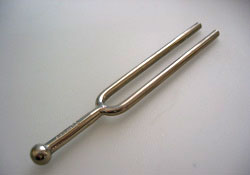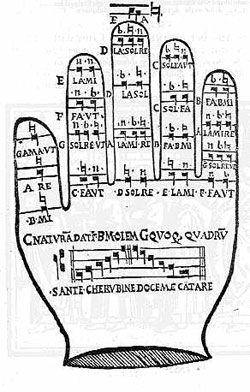|
|
|
 A diapason. Tuned at 440Hz it is used as reference by musicians.
Pitch: The pitch is the relative position of a sound in the scale, i.e. the height of the sound. It is related to frequency. Frequency says how often a vibration occurs per time unit.
Vibration is sinusoidal curve travelling up and down a resting line that forms a cycle.
Hertz is the modern unit for frequency and worth one cycle per second. The bounds of audibility for human ear are roughly from 40 to 5000 hertz.
As long as orchestras were made of spare instruments almost any frequency could be the reference to tune them up but modern big orchestras with double bass and piccolo-flute cover a large range of frequencies which are very near the bounds of audibility. That is the main reason why a fixed value had to be determined; others physical factors such sound speed had also to be taken into account. After the Vienna Convention of 1885, the standard became a tuning fork which yields 435 cycles per second (435 Hertz). Some more recent enhancements in instruments factory, such oboe, led to choose new values 440-442 Hertz. But why the 442 Hertz is assigned to A?
A simple explanation could be that “A” (sixth degree of the C major scale) is highest degree of the scale to support a perfect fifth. Clearly, that is not the reason which probably stems from solmisation evolved by Guido d’Arezzo (XI century).
 Image No. 1
Arithmetic proportion: 12-9=9-6=3
Harmonic proportion 12-8/8-6=4/2=2
Geometric proportion12/8=9/6=3/2
(see image No. 1)
6 and 12 are common to both series
9 is the Arithmetic mean (6+12)/2
8 is the Harmonic moiety 2*(6*12)/(12+6)
 Image No. 2
Exploring every combination, he could deduct
CF: 12/9=4/3=the fourth
CG: 12/8=3/2= the fifth
CC: 12/6=2/1= the octave
FG: 9/8=the ton
FC: 9/6=3/2=the fifth
GC: 8/6=4/3=the fourth
Numerous experiments resulted in a theory using combinations of 3 kinds of tetracord (set of 4 notes) based on perfect fourths that led to many different scales. A peculiar scale (called systema teleïon), consisting of two diatonic octaves (from A1 to A3) made of two disjoint tetracords, was rediscovered in the middle age. Here is the origin of the English and German notation. The B of the upper octave might be either flat or natural.
 Image No. 3
 Guido D' Arezzo Hand of Music
Beside the improvement in singing, the hexacord importance rested in transposition possibilities and counterpoint rules elaboration. Naturally this does not directly explain the “A”.
The range for average human voices (F2 to G5) requires a fictive 11 lines score with C3 on the sixth line. For readability score has been reduced to five lines with the letter C placed on the sixth line, F on the fourth line and G on the eighth line so that the part of the fictive score could be identified. Here is the origin of clefs.
Hexacord and central C put together enlighten the possible origin of “A” note as reference.
It must be pointed out that Bach respected the old rule of the “mi-fa hexacordum” that stated “when a melody reaches occasionally the seven degree of the scale it must be flat. Historical origin of hexacord is therefore a useful notion to know when the score is ambiguous.
Related resources:
The contents, views and opinions in this article are those of its author.
|
|
|
|
|
|